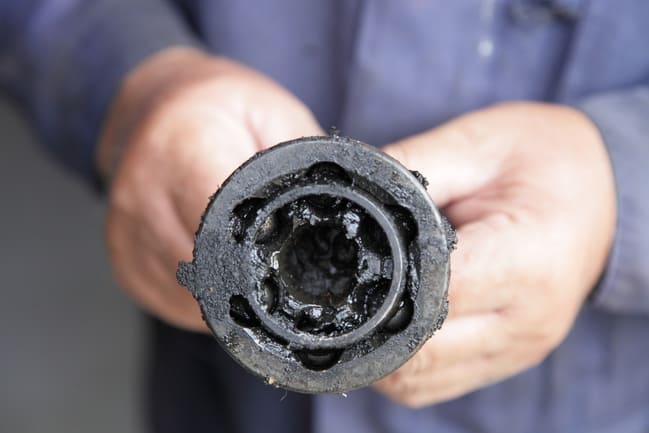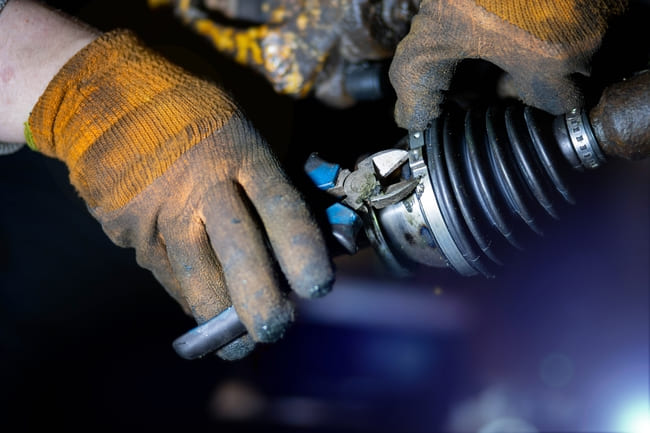Is your car bouncing all over the place when you’re driving on even roads? Is there an irritating clicking sound as you turn the steering wheel? These are both signs of a potentially serious problem with the joints on your car’s CV axle.

What is a CV joint?
Constant velocity (CV) joints, also commonly referred to as inboard and outboard joints, are located on both ends of the car drive shaft. They enable the shaft to transfer torque from the transmission to the wheels while allowing the driven wheels and the suspension to respond to changes in road conditions, i.e. bumps and potholes.
They play an essential role in maintaining a constant speed as the angle between the car transmission and wheels changes. The two main types of constant velocity joints are the ball-type joint and the tripod joint. The former consists of a series of steel balls contained in a metal cage, whereas the latter has three roller bearings connected to its body. Both types are designed to allow smooth movement in all directions.
How long does a car CV joint last?
As long as the boots are intact and properly sealed, the metal joints should last at least 70,000 miles. Some of them can last for 130,000 miles or more, depending on factors such as your driving style and maintenance routine.
If you drive off-road frequently or on rough, bumpy road surfaces, the parts are more likely to wear out faster. Due to the fact that rubber isn’t as durable as metal, the rubber boots protecting and sealing the joints usually need to be replaced after 80,000 miles. It is better to replace them sooner rather than later, otherwise you’ll probably need to get a new CV joint for your car.

Symptoms of CV joint failure
- Vibrations when driving
If there is too much play in the joints due to wear, it could cause the CV axle and other components to vibrate or shudder when accelerating and cruising at high speeds. However, there are other more common causes of this, including damaged wheels or tyres, bad bearings or damaged front or rear engine mounts. A proper inspection will be necessary to determine the problem.
- Grease in the wheel wells or on the tyres
These joints require a lot of lubrication to operate smoothly. The CV boot keeps the grease contained and contaminants out. If grease is lining the wheel wells and leaking onto the edges of the tyres, it is likely due to a busted boot. The quicker it is replaced, the less likely it is that the joint will get damaged.
- A bouncy car
One of the common signs of a bad CV joint is a bouncy vehicle. For instance, if you’re driving on a flat road surface and the vehicle is still bobbing up, down, and all around, there’s a good chance that the joint needs to be replaced. These parts play an important role in ensuring smooth driving and minimising vibrations.
However, you should never assume what the cause is without getting the car checked.
- Knocking, clicking or popping sounds when turning
You may hear an abnormal clicking or popping noise from the front wheels when you turn the steering wheel. This issue tends to get worse with time. If the noise is more obvious when turning at lower speeds, it could be due to the outboard joints. If there’s a CV joint noise when driving straight, it’s likely that there is a problem with the inboard components.
- Axle damage
If left untreated, a broken CV joint can damage the CV axle shaft, particularly the splines, due to increased vibration and stress or loose parts.
How much does a CV joint replacement cost (UK)?
These parts aren’t particularly expensive when compared to other components of car suspension system and steering. The joints themselves can cost anything between £20 and £150 depending on where you buy them from and the make, model and year of manufacture of the vehicle.
If you go to a professional mechanic, you’ll also need to factor in labour costs. Average prices for CV axle repairs range between £140 and £200 for most models. If the boots are worn, you can expect to pay around £80 to fit a new one.
To find affordable parts online, simply search using relevant keywords, e.g. “Ford Focus cv joint”, or the OEM part number.
TOP products on the subject:












































